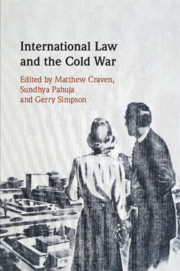Book contents
- International Law and the Cold War
- International Law and the Cold War
- Copyright page
- Dedication
- Contents
- Figures
- About the Editors
- About the Authors
- Acknowledgements
- 1 Reading and Unreading a Historiography of Hiatus
- Part I The Anti-linear Cold War
- Part II The Generative/Productive Cold War
- Part III The Parochial/Plural Cold War
- 16 The Cold War in Soviet International Legal Discourse
- 17 The Dao of Mao: Sinocentric Socialism and the Politics of International Legal Theory
- 18 ‘The Dust of Empire’: the Dialectic of Self-Determination and Re-colonisation in the First Phase of the Cold War
- 19 The ‘Bihar Famine’ and the Authorisation of the Green Revolution in India: Developmental Futures and Disaster Imaginaries
- 20 Pakistan’s Cold War(s) and International Law
- 21 International Law, Cold War Juridical Theatre and the Making of the Suez Crisis
- 22 To Seek with Beauty to Set the World Right: Cold War International Law and the Radical ‘Imaginative Geography’ of Pan-Africanism
- 23 John Le Carré, International Law and the Cold War
- 24 Postcolonial Hauntings and Cold War Continuities: Congolese Sovereignty and the Murder of Patrice Lumumba
- 25 End Times in the Antipodes: Propaganda and Critique in On the Beach
- References to Cold War Volume
- Index
25 - End Times in the Antipodes: Propaganda and Critique in On the Beach
from Part III - The Parochial/Plural Cold War
Published online by Cambridge University Press: 05 December 2019
- International Law and the Cold War
- International Law and the Cold War
- Copyright page
- Dedication
- Contents
- Figures
- About the Editors
- About the Authors
- Acknowledgements
- 1 Reading and Unreading a Historiography of Hiatus
- Part I The Anti-linear Cold War
- Part II The Generative/Productive Cold War
- Part III The Parochial/Plural Cold War
- 16 The Cold War in Soviet International Legal Discourse
- 17 The Dao of Mao: Sinocentric Socialism and the Politics of International Legal Theory
- 18 ‘The Dust of Empire’: the Dialectic of Self-Determination and Re-colonisation in the First Phase of the Cold War
- 19 The ‘Bihar Famine’ and the Authorisation of the Green Revolution in India: Developmental Futures and Disaster Imaginaries
- 20 Pakistan’s Cold War(s) and International Law
- 21 International Law, Cold War Juridical Theatre and the Making of the Suez Crisis
- 22 To Seek with Beauty to Set the World Right: Cold War International Law and the Radical ‘Imaginative Geography’ of Pan-Africanism
- 23 John Le Carré, International Law and the Cold War
- 24 Postcolonial Hauntings and Cold War Continuities: Congolese Sovereignty and the Murder of Patrice Lumumba
- 25 End Times in the Antipodes: Propaganda and Critique in On the Beach
- References to Cold War Volume
- Index
Summary
This chapter undertakes to explore a particular seismic shift in the fields of both thought and perception unfolding during the early part of the Cold War, as governments and publics grappled uneasily with the threat of nuclear war. I focus on the exploration of a particular cinematic event: the global release in late 1959 of the anti-nuclear war dystopian film On the Beach. Directed by the American Stanley Kramer and based on a 1957 novel by the British-Australian Nevil Shute, the film offers an opportunity to revisit and reflect on the tangled intersections between the cultural, legal and geopolitical orientations of this ‘hot’ Cold War moment from a new angle. While in 1959 an international legal architecture governing nuclear testing and nuclear non-proliferation had yet to emerge, the approach taken in this chapter suggests that a re-examination of this kind – that is attentive to the modes of perception (as well as discourse) that are emergent in this moment may be of interest to contemporary legal scholars seeking to make sense of a world in which nuclear threats have not abated, and international law’s role in managing that threat remains in question.
Keywords
- Type
- Chapter
- Information
- International Law and the Cold War , pp. 559 - 581Publisher: Cambridge University PressPrint publication year: 2019
- 1
- Cited by

